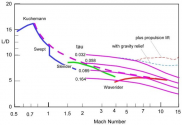It would be unrealistic, and frankly unreasonable, to expect the WS-15 to *exceed* the F135 or F119. Frankly it's already pretty monumental for the WS-15 to be in the same ballpark. At this point even if there is still a gap between the WS-15 and F135 it's not going to be a very big one. The WS-15 we are getting today is likely *way* more advanced than whatever they were planning to introduce back in the late 2000s.
The impression I've gotten following this topic for a decade now is that after the debacle that was the WS-10's initial introduction they went back to the drawing board for the WS-15's development and waited for critical enabling component technologies to mature before being satisfied with the design. The just get something out the door mentality was a necessity when China was backwards and poor and needed to have something just to maintain a bare minimum capability, but they've now figured out it is an absolutely terrible way to chase the technology frontier. Your designs have to come from much more advanced fundamental components and technologies, and the brunt of your energy and resources need to focus on those foundations if you want to chase cutting edge performance.
If you focus your resources on advancing your component technologies and make your design and product development process downstream of that your product development moves very quickly. If one component or another fails you will have a portfolio of other components to try to maintain a fast rate of iteration on your design. Furthermore, components development itself can iterate much faster on their own than if they're contingent on a larger integrated design stack. If you start with a design and then make component technologies downstream of that you will be forced to redo the whole development stack every time a component fails, since you will have to redevelop new components and wait on those to hit those design goals. The latter approach has only one superficial advantage to the former, which is that it is on paper cheaper. But even that advantage bleeds very quickly once you start hitting project delays. The lesson that product design has to come downstream from components and not vice versa has been critical for China's ability to close the technology gap. Rapid advanced product development cannot work without good optionality in your component technologies. This is why we are now seeing new engine developments happening so rapidly. The dam has finally broken loose.
One of the more important changes in China's aircraft engine development strategy is to separate the engine development from the aircraft development, which reflected in the formation/spin-off of AECC from AVIC. This is somewhat similar to your arguments about the detachment of component technologies development from the product development.
This was one of the key lessons that China learned in the decades of development experience of their aircraft industry. Before, development of each new aircraft engine was bundled with the development program of a new aircraft. Since aircraft engine development cycle is different from and usually longer than the aircraft development cycle. The results of this packaged development programs were that either the new aircraft flew without the intended engine or the cancellation of the aircraft engine development due to canceled aircraft program. Either way, the development of aircraft engines were stalled or stunted. A lot of these were due to lack of funding and China being poor and all that.
Now, aircraft engines have their own development cycles and roadmaps, and AECC can plan and invest in materials, components and product development at their own pace. Over time, this strategy has borne fruit and it has become a positive reinforcing loop between aircraft development and aircraft engine development. This is reflected in the generations and families of aircraft engines (WS-10A/B/C, WS-15; WS-13/WS-21, WS-19; WS-18, WS-20, CJ1000A, CJ2000, 5-generation engine etc.) and generations of aircraft (J-10/J-11B/J-16/J-20A/J-20B; J-31/J-35, Y-20A/Y-20B, C919, C929, 6-gen aircraft etc.).


